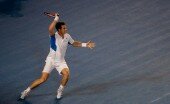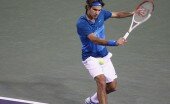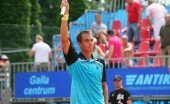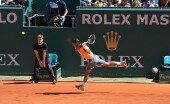Wimbledon 2011 – days one to four.
Written by Suhrith // June 24, 2011 // Sport // No comments
Four days have passed by at Wimbledon and there have been lots of charming little sub-plots that have captured attention. The tournament is as much about these side stories that are weaved into the larger tale as it is about the ultimate victors.
Day one, though, was sedate enough, almost as if to ensure that our adrenaline is preserved for greater drama that will doubtless ensue later. Rafael Nadal, the defending men’s champion as tradition warrants, opened proceedings on centre court – although other matches had begun a whole hour earlier in the smaller arenas – against Michael Russell of the United States. Russell goes by the nickname Iron Mike due to his penchant for lifting heavy weights, but against Nadal the weight of his groundstrokes paled in comparison and he was imperiously knocked off in three straight sets. Nadal is now a two times champion at Wimbledon, but the improvements that he has made to his movement on the grass continues to amaze. He isn’t inherently suited for grass like Federer who glides across it with an air of majesty, but having adapted to the surface’s vagaries his pace across the court and his natural shot making ability sufficiently negate any intrinsic weaknesses.
Venus Williams, over on court two – not the old cursed court two which has now become court three – saw off Akgul Amanmuradova with ease. It wasn’t so much her tennis that caught the attention, though, but her attire, which the Telegraph’s Mark Hodgkinson said was the “closest that anyone has ever come to wearing a cut-off toga to this garden party.” You can judge for yourself.
Also on day one, Andy Murray – ‘carrying the weight of a nation on his shoulders’ – overcame a first set loss to oust Daniel Gimeno-Traver of Spain under the 100 million pound roof on Centre Court. Murray’s performance didn’t cause the jaw to drop, but upon settling down his pleasing array of little lobs and drops were in abundant evidence.
***
Day two certainly saw an upscale in the story quotient. First on centre-court was Serena Williams, who hadn’t played a Grand Slam since winning Wimbledon last year. Bouts of depression followed and Serena says she went through a near-death experience four months back – suffering from pulmonary embolism in February with clots on both her lungs. Against France’s Aravane Rezai she was far from her best, but recovered, as she often tends to do after a first set loss, and powered her groundstrokes in characteristically domineering fashion. Her harrowing break began with an injury to the foot – the cause of which she herself is unaware of – and continued onto the surgery that was required to remove the clots on her lungs. Anyway, she’s back now and still looks the best player in the world. And with Venus in the other side of the draw, who’d say no to an all Williams clash in the final.
Roger Federer, Novak Djokovic and Maria Sharapova, in that order, followed Serena onto centre court and each enjoyed easy straight sets victories. It was the match fourth up on the new court three, though, that everyone was waiting for. John Isner and Nicholas Mahut having played a remarkable eleven-hour match last year that stretched over three days before Isner prevailed 70-68 in the fifth set had through a weird play of fate been drawn against each other. Isner came through yet again, though in far more normal circumstances, 7-6, 6-2, 7-6 – not the most engaging of contests, but its history certainly added to the fascination.
***
First up on centre court on day three was, perhaps, the story of the tournament thus far. Forty-year-old – yes you read that right – Kimiko Date Krumm was up against Venus Williams in the second round. Date Krumm retired in 1996 – a year in which she reached the semi-finals of Wimbledon and a year in which she was still Kimiko Date. Since then, she has married German racer Michael Krumm before making a remarkable return to the game twelve years after her retirement.
In her earlier stint, I must admit, I was scarcely her fan , for the same reasons expounded in this lovely piece by Louisa Thomas in Grantland. Kimiko in 1996 played Steffi Graf in the semi-final and she had the audacity to take a set off Graf! Not something that went down well, I am sure, with most fans. Nonetheless, her display against Venus Williams – although she ultimately came a cropper in the deciding set – was amongst the most charming I’ve seen in quite some time. Not merely because of her ability to compete at her age, which is no doubt inspirational, but her style of tennis which was a throwback to a bygone era. She thrillingly served and volleyed, chipped, lobbed and dropped and left Venus befuddled in a first set, which she took through a tiebreaker. Ultimately her age and fitness meant that Venus’s game based on brute force – albeit a nous-filled one – would prevail. But it showed that there is still a place for the ‘old-fashioned’ style on grass and that it is a viable tactic even against the hardest of hitters.
Also on day three, Andy Roddick, Nadal, Murray and Tomas Berdych, all potential quarterfinalists sailed into the third round with little fuss. So too did Czech Petra Kvitova, who with her beautiful ball-striking abilities could be a dangerous opponent to encounter in the second week.
***
Lleyton Hewitt is well past his best. He isn’t anywhere near the force that he was when he won Wimbledon in 2002. But he remains a great competitor – forever plucky and tenacious. Against fifth seed Robin Soderling, yesterday, on day four, he pulled off the first two sets through typical counter-punching brilliance amid several screams of ‘come-on,’ which strangely have lost their annoying twang – maybe it’s because of my own tolerance of the aged contestant. In sets three, four and five, though, all of which were closely fought, Soderling prevailed, eventually finding depth, angle and timing on his extraordinarily fierce groundstrokes. This may be the last time we see Hewitt play on the hallowed grass of SW 19 and it was a performance that even if ultimately unsuccessful, glowingly displayed many of his admirable traits.
Hewitt-Soderling was followed by another match where character and guts were in plentiful display. Li Na, coming off her recent triumph at Roland Garros faced Germany’s wildcard entrant Sabine Lisicki. A quarterfinalist in 2009, Lisicki was seemingly destined to rise into the top echelons of the women’s game, but an ankle injury reduced her to walking on crutches for seven weeks and sent her ranking plummeting below 200. A victory at Birmingham leading up to Wimbledon saw her secure a wildcard, a decision, which now looks richly deserved. Li picked up the first set 6-3 and looked good for a simple victory, but a combination of huge serving – one of her aces was recorded at 122 miles per hour – and magnificent striking off the forehand wing saw Lisicki come back to take sets two and three 6-4, 8-6. This would usually be a cue for me to berate the quality of some of the top ranked women players, but this was an occasion on which the tennis, particularly in the latter phases, was of superb quality.




